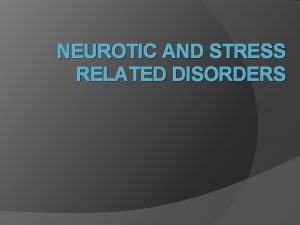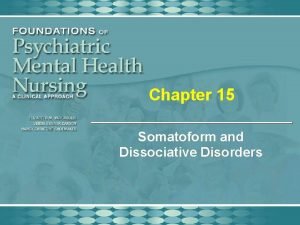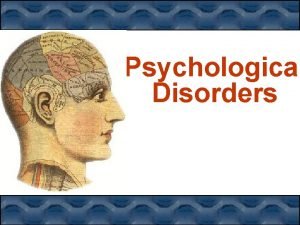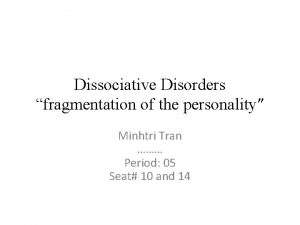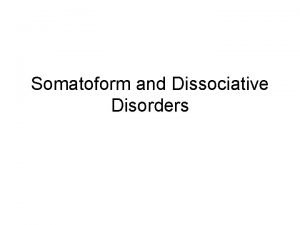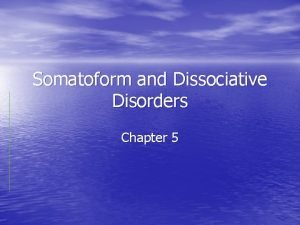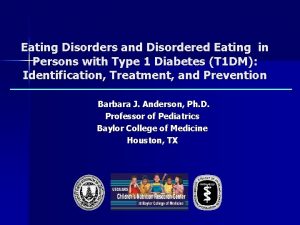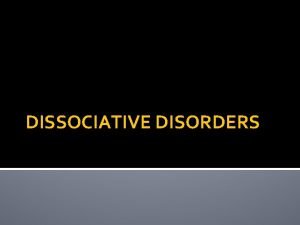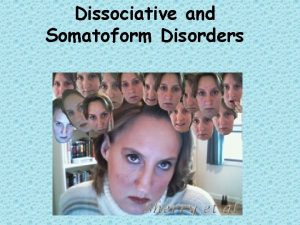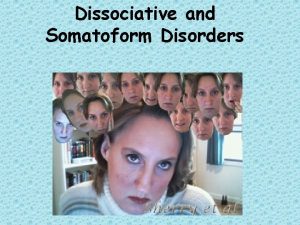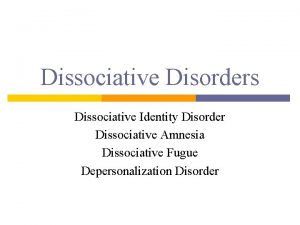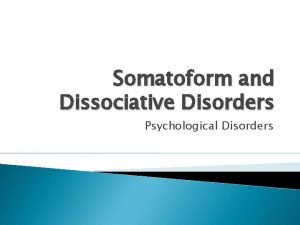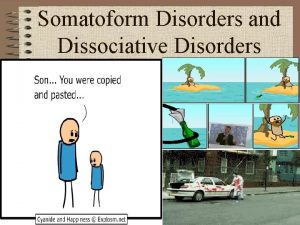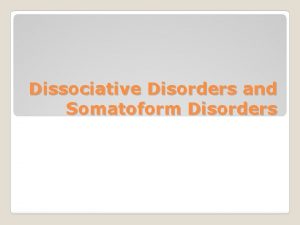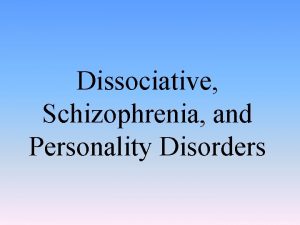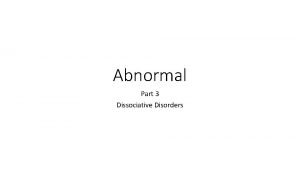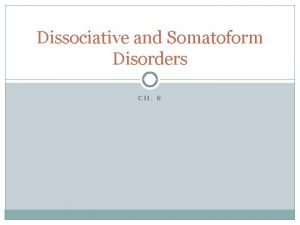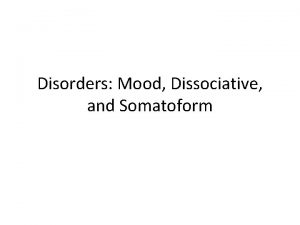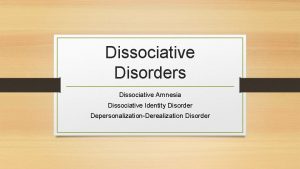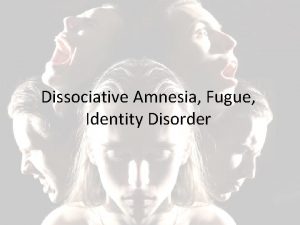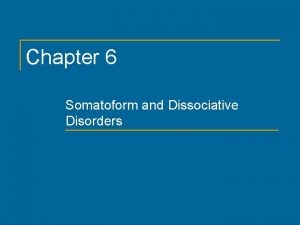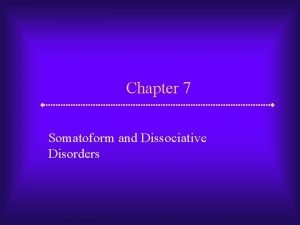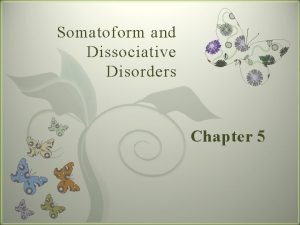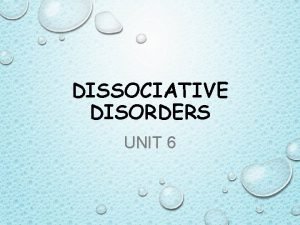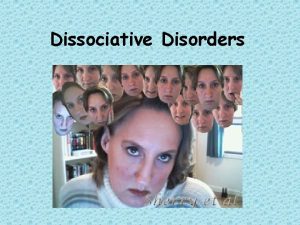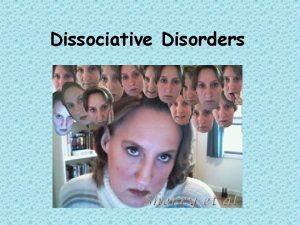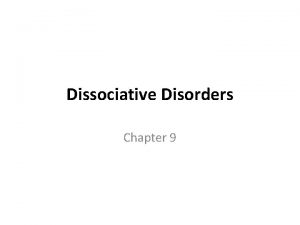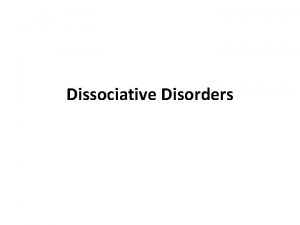Somatoform and Dissociative Disorders Somatoform Disorders Soma Meaning

























- Slides: 25

Somatoform and Dissociative Disorders

Somatoform Disorders • Soma – Meaning Body – Preoccupation with health and/or body appearance and functioning – No identifiable medical condition causing the physical complaints • Types of DSM-IV Somatoform Disorders – Hypochondriasis – Somatization disorder – Conversion disorder – Pain disorder – Body dysmorphic disorder

Hypochondriasis • Clinical Description – Physical complaints without a clear cause – Severe anxiety focused on the possibility of having a serious disease – Strong disease conviction – Medical reassurance does not seem to help • Statistics – Good prevalence data are lacking – Onset at any age, and runs a chronic course

Hypochondriasis: Causes and Treatment • Causes – Cognitive perceptual distortions – Familial history of illness • Treatment – Challenge illness-related misinterpretations – Provide more substantial and sensitive reassurance – Stress management and coping strategies

Integrative model of causes of hypochondriasis Figure 5. 1

Somatization Disorder • Clinical Description – Extended history of physical complaints before age 30 – Substantial impairment in social or occupational functioning – Concerned over the symptoms themselves, not what they might mean – Symptoms become the person’s identity • Statistics – Rare condition – Onset usually in adolescence – Mostly affects unmarried, low SES women – Runs a chronic course

Somatization Disorder: Causes and Treatment • Causes – Familial history of illness – Relation with antisocial personality disorder – Weak behavioral inhibition system • Treatment – No treatment exists with demonstrated effectiveness – Reduce the tendency to visit numerous medical specialists – Assign “gatekeeper” physician – Reduce supportive consequences of talk about physical symptoms

Conversion Disorder • Clinical Description – Physical malfunctioning without any physical or organic pathology – Malfunctioning often involves sensory-motor areas – Persons show la belle indifference – Retain most normal functions, but without awareness of this ability • Statistics – Rare condition, with a chronic intermittent course – Seen primarily in females, with onset usually in adolescence – Not uncommon in some cultural and/or religious groups

Conversion Disorder: Causes and Treatment • Causes – Freudian psychodynamic view is still popular – Emphasis on the role of trauma, conversion, and primary/secondary gain – Detachment from the trauma and negative reinforcement seem critical • Treatment – Similar to somatization disorder – Core strategy is attending to the trauma – Remove sources of secondary gain – Reduce supportive consequences of talk about physical symptoms

Body Dysmorphic Disorder • Clinical Description – Preoccupation with imagined defect in appearance – Either fixation or avoidance of mirrors – Previously known as dysmorphophobia – Suicidal ideation and behavior are common – Often display ideas of reference for imagined defect • Statistics – More common than previously thought – Usually runs a lifelong chronic course – Seen equally in males and females, with onset usually in early 20 s – Most remain single, and many seek out plastic surgeons

Body Dysmorphic Disorder: Causes and Treatment • Causes – Little is known – Disorder tends to run in families – Shares similarities with obsessive-compulsive disorder • Treatment – Treatment parallels that for obsessive compulsive disorder – Medications (i. e. , SSRIs) that work for OCD provide some relief – Exposure and response prevention are also helpful – Plastic surgery is often unhelpful


Summary of Somatoform and Dissociative Disorders (cont. ) Figure 6. x 1 (cont. ) Exploring somatoform disorders

An Overview of Dissociative Disorders • Overview – Involve severe alterations or detachments in identity, memory, or consciousness – Depersonalization – Distortion is perception of reality – Derealization – Losing a sense of the external world – Variations of normal depersonalization and derealization experiences • Types of DSM-IV Dissociative Disorders – Depersonalization Disorder – Dissociative Amnesia – Dissociative Fugue – Dissociative Trance Disorder – Dissociative Identity Disorder

p. 207

Depersonalization Disorder: An Overview • Overview and Defining Features – Severe and frightening feelings of unreality and detachment – Such feelings and experiences dominate and interfere with life functioning – Primary problem involves depersonalization and derealization • Facts and Statistics – Comorbidity with anxiety and mood disorders is extremely high – Onset is typically around age 16 – Usually runs a lifelong chronic course

Depersonalization Disorder: Causes and Treatment • Causes – Show cognitive deficits in attention, short-term memory, and spatial reasoning – Such persons are easily distracted – Cognitive deficits correspond with reports of tunnel vision and mind emptiness

Dissociative Amnesia and Dissociative Fugue: An Overview • Dissociative Amnesia – Includes several forms of psychogenic memory loss – Generalized type – Inability to recall anything, including their identity – Localized or selective type – Failure to recall specific (usually traumatic) events • Dissociative Fugue – Related to dissociative amnesia – Such persons take off and find themselves in a new place – Lose ability to remember the past and relocation – Such persons often assume a new identity

Dissociative Amnesia and Fugue: Causes and Treatment • Statistics – Dissociative amnesia and fugue usually begin in adulthood – Both conditions show rapid onset and dissipation – Both conditions occur most often in females • Causes – Little is known, but trauma and stress seem heavily involved • Treatment – Persons with dissociative amnesia and fugue usually get better without treatment – Most remember what they have forgotten

Dissociative Trance Disorder: An Overview, Causes, and Treatment • Clinical Description – Symptoms resemble those of other dissociative disorders – The clinical presentation varies across cultures – Involves dissociative symptoms and sudden changes in personality – Symptoms and personality changes are often attributed to possession by a spirit – Symptoms must be considered undesirable/pathological by the culture • Facts and Statistics – More common in females than males • Causes – Often attributable to a life stressor or trauma

Dissociative Identity Disorder (DID): An Overview • Clinical Description – Involves adoption of several new identities (as many as 100) – Identities display unique sets of behaviors, voice, and posture – Formerly known as multiple personality disorder – Defining feature is dissociation of certain aspects of personality • Unique Aspects of DID – Alters – Refers to the different identities or personalities in DID – Host – The identity that seeks treatment and tries to keep identity fragments together – Switch – Often instantaneous transition from one personality to another

• Dissociative Identity Disorder (DID): Causes and Treatment Statistics – Average number of identities is close to 15 – Ratio of females to males is high (9: 1) – Onset is almost always in childhood – High comorbidity rates, with a lifelong chronic course • Causes – Almost all patients have histories of horrible, unspeakable, child abuse – Closely related to PTSD – Most are also highly suggestible – DID is viewed as a mechanism to escape from the impact of trauma • Treatment – Focus is on reintegration of identities – Aim is to identify and neutralize cues/triggers that provoke memories of trauma/dissociation

Diagnostic Considerations in Somatoform and Dissociative Disorders • Separating Real Problems from Faking – The Problem of Malingering – Deliberately faking symptoms • False Memories and Recovered Memory Syndrome

Summary of Somatoform and Dissociative Disorders • Features of Somatoform Disorders – Physical problems without on organic cause • Features of Dissociative Disorders – Extreme distortions in perception and memory • Well Established Treatments Are Generally Lacking

 Neurotic stress-related and somatoform disorders
Neurotic stress-related and somatoform disorders Neurotic stress-related and somatoform disorders
Neurotic stress-related and somatoform disorders Nursing care plan for somatoform disorder
Nursing care plan for somatoform disorder Somatoform disorders
Somatoform disorders Types of somatic disorder
Types of somatic disorder Dissociative disorders
Dissociative disorders Types of dissociative disorders
Types of dissociative disorders Dissociative fugue
Dissociative fugue Somatoform disorder
Somatoform disorder Gangguan somatoform
Gangguan somatoform Hyperventilation syndrome
Hyperventilation syndrome Epidemiologi gangguan somatoform
Epidemiologi gangguan somatoform Associative and dissociative social process
Associative and dissociative social process Secondary gain
Secondary gain Dissociative fugue
Dissociative fugue Dissociative amnesia
Dissociative amnesia Bask model of dissociation
Bask model of dissociation Dissociative disorder not otherwise specified
Dissociative disorder not otherwise specified Dr stephen andersen
Dr stephen andersen Dissociative disorder not otherwise specified
Dissociative disorder not otherwise specified Dissociative disorder
Dissociative disorder Dissociative fugue
Dissociative fugue Dissociative amnesia
Dissociative amnesia Dissociative fuge
Dissociative fuge La belle indifference definition
La belle indifference definition Dissociative identity disorder social security disability
Dissociative identity disorder social security disability
